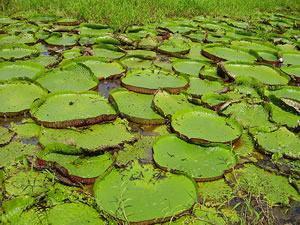Rivers and streams in the tropical rainforest create openings where sunlight can reach ground level.
Trees, shrubs, climbers and herbs take advantage of this light, forming dense walls of greenery.
Plants that grow beside rivers have evolved efficient systems for carrying oxygen to their roots.
About 65 per cent of soil is made up of air-filled spaces between the particles of earth. These can usually provide enough oxygen for plants.
However, if the soil is very wet, and unable to drain freely, the spaces become filled with water. Oxygen moves 10,000 times more slowly through water than through air, and when the soil oxygen has been used up by roots, bacteria and fungi, it cannot be replaced quickly.
The soil then becomes anaerobic, or devoid of oxygen.
All plants have air spaces between their cells. However, in swamp plants, the spaces in the stems and leaves are so large that they combine to form air canals through which oxygen can pass to the roots.
Some swamp trees have side roots that grow up into the air instead of down into the soil. In the aerial parts of these roots small pores, or lenticels, allow oxygen to enter the air spaces of the roots so that the plant can breathe.
Plants that grow beside fast-flowing tropical rainforest streams are threatened by the possibility of waters can rise quickly and submerging them, or of rapid currents tearing off leaves and branches.
Many of these plants, which include palms, have long, narrow leaves that offer little resistance to the water.
A number of riverside plants in the tropical rainforest float and are spread by the flowing water.
Others have seeds or fruits with fleshy coats. Fish digest the fleshy part, leaving the seeds ready to germinate, possibly far down the riverbank.
 Many submerged water plants can be found in the slow flowing rivers and backwaters of the Amazon basin. Other water plants, like the famous giant water lily, Victoria amazonica, are rooted in the riverbed but have floating leaves and flowers at the surface.
Many submerged water plants can be found in the slow flowing rivers and backwaters of the Amazon basin. Other water plants, like the famous giant water lily, Victoria amazonica, are rooted in the riverbed but have floating leaves and flowers at the surface.
The mosslike members of the family Podostemaceae, or riverweeds, can be found in fast-flowing streams in the Amazon basin, as well as in streams in tropical rainforests in Africa and Southeast Asia.
These plants consist of just a lobed stem that clings to rock. They do not have real leaves or roots. Small flowers sprout from the stems when the water level drops and the plants are exposed to air.